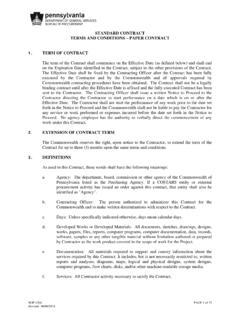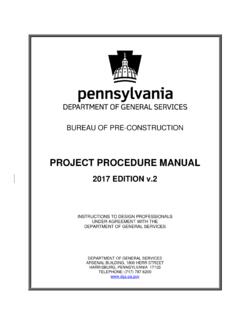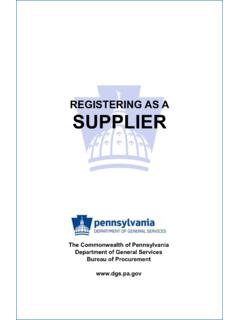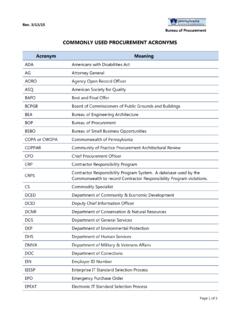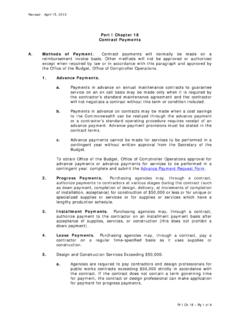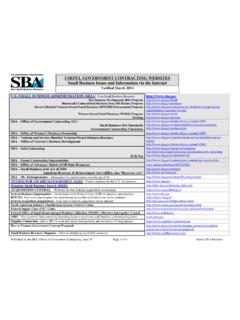Transcription of Part I Chapter 06 Methods of Awarding Contracts A. 1. a. b.
1 Revised: April 30, 2015. Part I Chapter 06. Methods of Awarding Contracts A. Competitive Sealed Bidding. 1. Conditions for Use. a. Contracts must, as a general practice, be awarded through the competitive sealed bidding method of award. b. Competitive sealed bidding is the traditional and usual method of contractor selection. It is normally used when the supply, service, or construction can be satisfactorily described and price is the only factor to be considered in the award, after bidder responsibility is determined. c. There is limited discretion in the award process. Discretion is limited to: (1) Discretion in determining bidder responsibility. (2) Discretion in determining whether the bid is responsive. (3) Discretion to reject all bids. 2. Invitations for Bids (IFBs). a. The document, either paper or electronic, which is issued for the solicitation of bid, is an IFB. b. The IFB must include: (1) A procurement description.
2 (2) Criteria to determine acceptability, including instructions and information for bidders. (3) Evaluation criteria. (4) All contractual terms (whenever practical) and conditions applicable to the procurement; , delivery or performance schedules, warranty, bonding, and security requirements. (5) Signature page, unless the bid received via the Commonwealth's electronic procurement system. c. The procurement description is the words used in the solicitation to describe the supplies, services, or construction to be procured. The term includes the specifications. (The specifications must be attached to or made a part of the solicitation.). d. The criteria to determine acceptability may include: inspection, testing, Pt I Ch 06 Pg 1 of 37. Revised: April 30, 2015. quality, workmanship, delivery, and suitability for a particular purpose. e. Evaluation criteria that will affect the price and be considered in the evaluation for the award must be objectively measurable, such as discounts, transportation costs, and total or life cycle costs.
3 (1) No criteria may be used in the bid evaluation that is not set forth in the IFB. (2) Life cycle cost is the total cost of the supply in terms of purchase price, installation costs, maintenance costs, energy costs, material cost, and other costs. (3) Bidding preferences, such as the Reciprocal Limitations Act preference and the preference for products with recycled post consumer material are evaluation criteria. f. There are obvious disadvantages if all the contract terms and conditions are not included in the IFB including: (1) Lengthier contract process. (2) No meeting of the minds. (3) Common standard is possibly changed. g. The IFB establishes the common standard upon which all bidders must submit their bids. 3. Public Notice. a. Adequate public notice must be given a reasonable time prior to the bid opening date. (1) "Adequacy" of public notice is within the policy-making power and discretion of the purchasing agency.
4 (a) The acceptable Methods of public notice include any of the following: i. Electronic publication which is accessible to the general public. ii. Advertisement as provided for in 45 Pa. 306. (relating to the use of trade publications). iii. Issuance of IFBs to bidders on the solicitation mailing list of the purchasing agency. iv. Publication in a newspaper of general circulation. v. Where prequalification is a requirement of submitting a bid, notification to all contractors Pt I Ch 06 Pg 2 of 37. Revised: April 30, 2015. who have been prequalified by the purchasing agency. (b) The Department of General Services' requires notice of all Commonwealth executive and independent agency contracting opportunities for supplies, services, and construction over $10,000 to be published electronically at the Department of General Services' website. (c) Copies of IFBs must be made available to any interested person upon request to the purchasing agency.
5 (d) Purchasing agencies may establish procedures for the distribution of IFBs including the imposition of a fee to reimburse the agency for the costs of photocopying and mailing. (2) Bidder must be given a reasonable time between the date of public notice and the bid opening to obtain a copy of the IFB to prepare their bids and to submit their bids. Reasonable Time . is within the discretion of the purchasing agency. b. Copies of IFBs must be made available to any interested person upon request to the purchasing agency. c. Purchasing agencies may establish procedures for the distribution of IFBs including the imposition of a fee to reimburse the agency for the costs of photocopying and mailing. 4. Bid Opening. a. Bids must be opened publicly in the presence of one or more witnesses at the time and place designated in the IFB. b. The purchasing agency must record and make available for public inspection, the following information.
6 (1) The name of each bidder;. (2) The amount of each bid; and (3) Any other relevant information as may be specified by regulation. c. The prepared written record of the bidders and bid information (bid tabulation) must be posted to eMarketplace as soon as reasonably possible. 5. Bid Acceptance and Evaluation. a. Any bid received after the time and date set for bid opening is late and shall not be considered for award unless the bid would have been timely but for the action or inaction of Commonwealth personnel Pt I Ch 06 Pg 3 of 37. Revised: April 30, 2015. directly serving the procurement activity. b. Bids must be unconditionally accepted without alteration or modification except as authorized by law or in the IFB. c. Bids must be evaluated based upon the requirements set forth in the IFB. (1) The purchasing agency must determine whether a bid is acceptable based upon the acceptability criteria in the IFB. (2) It is important to note that the acceptability evaluation is not documented for the purpose of determining whether one bidder's item is superior to another but only to determine that a bidder's offering is acceptable as set forth in the IFB.
7 (3) The purchasing agency must also evaluate the bids in accordance with the evaluation criteria which may affect bid prices and the order of award ( , lifecycle cost). d. In order to be acceptable, a bid must be responsive, that is, it must conform in all material respects to the requirements in the IFB. (1) A slight or immaterial variance from the terms and conditions or the specifications contained in the IFB does not destroy the competitive character of the bid so as to require rejection. Those errors which superficially deviate from normal practice do not taint an otherwise acceptable award if the discrepancy does not transgress the actual terms of the bid instructions. (2) The IFB should reserve the right for the purchasing agency to waive technical defects or informalities. Therefore, waiving a defect is not an automatic violation of competitive bidding. Instead, it must be determined whether the waiver of any defects will cause the competitive bidding process to be noncompetitive.
8 (3) If the variance in bid gives the bidder an advantage or benefit not enjoyed by other bidders, competitive bidding is destroyed. Mandatory, competitive bidding requirements must be followed. (4) Post-bid negotiations are prohibited. e. A bidder cannot modify its bid by removing exceptions to the bid instructions or by supplying missing documentation required by the bid instructions. Once a bid is opened, it cannot be modified. f. Once a bid is determined to be nonresponsive, it may not be made responsive after bid opening notwithstanding the reason for the failure to conform. Responsiveness of a bid is determined as of bid opening time and must be determined from the bid itself not evidence outside of the bid documents. Pt I Ch 06 Pg 4 of 37. Revised: April 30, 2015. 6. Resolving Tie Bids. a. In procurements where two or more responsive and responsible bidders have bid the exact same amount (as may be defined in the solicitation) for a line item (if the award is being made by line item) or for the entire bid (if the award is being made for all line items), the issuing officer must break the tie.
9 Unless the solicitation provides for a special process to break a tie bid, the issuing officer shall notify the affected bidders of the tie and request a voluntary discount from them to be due at a specified date and time. If this does not resolve the tie or is not practical, the issuing officer may consider any or a combination of the following factors in order to break the tie: (1) One of the bidders is a Department of General Services Certified Small Business;. (2) One of the bidders is a Pennsylvania bidder or a Pennsylvania manufacturer;. (3) One of the bidders is offering a more advantageous delivery date;. (4) One of the bidders' products has a greater recycled content;. (5) The bidders' past performance with the Commonwealth;. (6) Awarding to one of the bidders would equalize the awards resulting from the bid; and (7) Awarding to one of the bidders' offers an administrative advantage as the bidder will also be awarded other line items.
10 B. If none of the above options are practical or do not result in breaking the tie, the issuing officer may utilize a coin flip to resolve the tie. If this method is to be used, the issuing officer must notify the affected bidders no less than 48 hours prior to the coin flip to allow for the bidders or their designees to be present, if they so choose, to witness the coin flip. In addition, any coin flip will be open to the public. c. The issuing officer shall document all steps taken in resolving the tie and include them in the contract file. 7. Award. a. Award must be made within 60 days after bid opening. Extensions of the date for the award may be made by mutual written consent of the contracting officer and the lowest responsible and responsive bidder. b. Award must be made to the lowest responsible bidder whose bid meets the requirements and criteria set forth in the invitation for bids unless all bids are rejected or the lowest responsible and responsive bidder is allowed to withdraw his or her bid.



